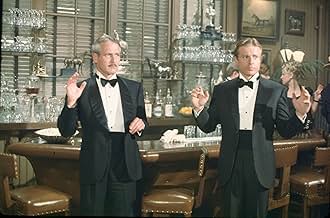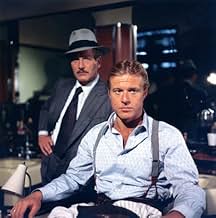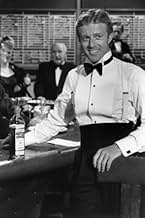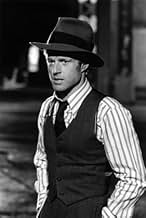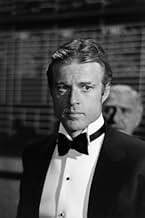In Chicago möchte ein junger Hochstapler sich im September 1936 für den Mord an seinem Partner rächen und tut sich mit dem größten aller Trickbetrüger zusammen, um einem kriminellen Banker e... Alles lesenIn Chicago möchte ein junger Hochstapler sich im September 1936 für den Mord an seinem Partner rächen und tut sich mit dem größten aller Trickbetrüger zusammen, um einem kriminellen Banker ein Vermögen abzuluchsen.In Chicago möchte ein junger Hochstapler sich im September 1936 für den Mord an seinem Partner rächen und tut sich mit dem größten aller Trickbetrüger zusammen, um einem kriminellen Banker ein Vermögen abzuluchsen.
- 7 Oscars gewonnen
- 18 Gewinne & 6 Nominierungen insgesamt
- Luther Coleman
- (as Robertearl Jones)
- Mottola
- (as James J. Sloyan)
Zusammenfassung
Empfohlene Bewertungen
That must have been tough for the Academy voters because to single out Redford as opposed to Paul Newman must have felt a bit unjust. For though Newman was nominated many times over his career and finally did win for The Color of Money, did not get a nomination for The Sting.
Robert Redford is a small time grifter who while working a bait and switch street con takes off a numbers runner carrying the weekly take. The orders come down from the head man himself, Irish-American gangster Robert Shaw to kill those who did this as an example.
Redford's mentor, Robert Earl Jones, is in fact killed, mainly because Redford starts spending a lot of that newly acquired loot that tips them off. Redford wants revenge so he looks up big time con man Paul Newman who himself is dodging law enforcement as is Redford also.
They work the big con on Shaw and it's a beauty. The scheme they have is something to behold. They also have to do a couple of improvisations on the fly that lend a few twists to the scheme.
The costumes and sets really do evoke Chicago of the Thirties and director George Roy Hill assembles a great cast to support Newman and Redford. My favorite in the whole group is Charles Durning, who plays the brutally corrupt, but essentially dumb cop from Joliet who nearly gums up the works and has to be dealt with.
Special mention should also go to Robert Shaw. He's got a difficult part, maybe the most difficult in the film. He's not stupid, he would not have gotten to the top of the rackets if he was. But he also has to show that hint of human weakness that Newman, Redford, and the whole mob they assemble that makes him vulnerable to the con.
During the sixties and seventies Robert Shaw was really coming into his own as a player, getting more and more acclaim for his work. His early death was a real tragedy, there was so much more he could have been doing.
Can't also forget another co-star in this film, the ragtime music of Scott Joplin that was used to score The Sting. It probably is what most people remember about The Sting. Music from the Theodore Roosevelt era, scoring a film set in the Franklin Roosevelt era made while Nixon was president. Strange, but it actually works.
The Sting still works wonders today.
Almost a follow up to Butch and Sundance, this film partners the stars of the day Newman and Redford to good effect. The story is a little less fun but still very enjoyable to watch as it builds to a great finale. The use of chapters ran the risk of fragmenting the film into bits but instead it really helps set it out and makes it more manageable. Although it is not as light hearted and jovial as the theme music suggests it still manages to flow nicely with the slightly darker drama not spoiling anything but only serving to make it feel more grown up.
The cast are all very good and make the film easy to watch. Redford comes off the best in terms of characters and his role really suits both his carefree attitude (the start of the film) but also his more serious side (the rest of the film). Newman has a lesser role that perhaps doesn't suit him quite as well, but he does have several really good scenes (the hustles) where he does very good work. Shaw's accent is a little heavy at first but I got used to it and it worked for me and he was a really good foil for Redford/Newman. The support cast including Durning, Walston, Gould, Jones and others all do good work.
The direction and use of music is really good and the sense of period is well crafted and doesn't just feel like it was painted on. I'm not sure if it deserved Best Picture or not because I don't know what the rest of the field was for that year but it is a really enjoyable film that is quite fun to watch several times even 30 years later and isn't that the main thing?
Perpetual perfection that continues to deliver to this day.
"The Sting" was devised as a follow-up to "Butch Cassidy", reuniting Newman and Redford as lovable, wisecracking rogues. The motivation behind the project may have been cynical box-office manipulation, but the resulting film is a beauty. The two stars make a great team, and multi-faceted confidence tricks adorn the plot in Byzantine complexity.
Lonnegan (Robert Shaw) has two prominent personality traits - greed and cruelty. A con is put together which will use these characteristics against their owner. The best way to hurt Lonnegan is to dupe him out of his money, because the sharks of the criminal fraternity will turn on him once they see that he's been 'had'. It is essential that Lonnegan must never know that this was a scam, because if he did, he would pursue a vendetta against our heroes. He must believe that he lost his money through his own stupidity, and that the men who took it are now dead.
The opening scenes emphasise the harshness of a world in which powerful crooks fleece ordinary joes, but also stress the warmth of the social bond which unites the small-time thieves. Mottola is a runner for Lonnegan's operation, a heartless dandy who steals a desperate man's dough (or so he thinks). The gambling dens ruthlessly swindle Hooker out of his money, but Hooker makes no trouble for the croupier, a guy just like himself who is merely trying to survive.
Redford plays Hooker to perfection. He is the handsome, charming 'man of the people'. There is no malice in him, and yet he spends his life ducking, diving and dodging lead. Luther was his father figure, and we see Hooker transfer his filial allegiance to Gondorff.
The film is crammed with technical cleverness. Whoever went out and scouted for locations did a great job, because the gritty 1930's look is wonderful. If the streets around the bookie's shop were 'faked' on a back lot, then this alone would make "The Sting" outstanding. Watch the urban period detail as Lonnegan goes across to place his first bet, and again at the start of "The Wire". Hooker suddenly realises that Luther is dead, and we see 'the penny drop' by means of a very simple but very effective device - the camera zooms back. No redundant dialogue, no over-acting. The panoramic view from above the rail tracks is achieved by 'masking in' a photograph of old Joliet, to create a convincing skyline. During the poker game on the train, the focus is thrown from Lonnegan's cards to Gondorff's eyes. We know that Gondorff knows that Lonnegan is cheating.
The music cannot go unmentioned. Apart from being exquisite, it contributes a major part of the film's overall feel. "The Sting" introduced the piano rags of Scott Joplin to a mass audience, and their popularity has not diminished over the ensuing decades. Composed perhaps forty years before the events they illustrate, and therefore 'wrong' from a period point of view, the pieces are none the less perfect, and the film is unimaginable without them. As a fun accompaniment to the music, the film contains various silent-era 'wipes'. Watch for the changes of scene for the iris-ins and iris-outs, and vertical and horizontal wipes.
David Ward's script is intelligent and intricate. The 'big con' has safety features built into it, such as the well-worked 'shut-out'. In order for the audience to take the swindlers to their hearts, it is necessary to depict the cops as venal, immoral and downright sleazy. Local dick Snyder is all of this, and more, his character being a masterpiece of dimwitted malevolence.
Eileen Brennan (Captain Lewis in "Private Benjamin") plays Billie, Gondorff's partner. She turns in a performance of cool assurance, one of the film's subtler treats. Charles Dierkop is simply marvellous as Floyd. This veteran of "Butch Cassidy" has hardly any dialogue, but he makes Floyd central to the film's comic purpose - and does it all with nuances of gesture. The FBI agents are great. Wearing straw boaters more than a decade after straw boaters ceased to be cool, and persisting with them even in torrential rain, the G-men are the archetype of Hooverian 'squareness'.
It may be fanciful, but are there passing references to Hitchcock's "Strangers On A Train"? The carrousel may be stretching a point, but what of Mottola's feet at the start, wearing Robert Walker's shoes?
"The Sting" is a splendid film. The plot may perform bewildering gyrations, Robert Shaw's Irish accent may be somewhat shaky, and Solino may be an assassin too far - but the whole of this complicated contraption works, and works well. I can recall, back in 1974, an excited cinema audience actually cheering and shouting at the screen.
"Seems worthwhile, doesn't it?"
Oscars Best Picture Winners, Ranked
Oscars Best Picture Winners, Ranked
Wusstest du schon
- WissenswertesPaul Newman and Robert Redford were each paid $500,000 for their role, the highest rate for an actor working at that time. Adjusted for inflation, that is equal to about $3 million (2022). The year before this Marlon Brando earned $3 million from Der letzte Tango in Paris (1972) but that included profit participation.
- PatzerIn the bathroom, Hooker can be seen saying, "He didn't tell me you was a fuck-up either." This has been looped to replace it with the less profane "He didn't tell me you was a screw-up either." (The grammar error is scripted.)
- Zitate
Johnny Hooker: Can you get a mob together?
Henry Gondorff: After what happened to Luther, I don't think I can get more than two, three hundred guys.
- Crazy CreditsThe opening animated logo for Universal Pictures is in 1930s style, matching the movie's setting, instead of the 1970s version.
- VerbindungenFeatured in Oscars, Actors and The Exorcist (1974)
Top-Auswahl
- How long is The Sting?Powered by Alexa
- Why does Lonnegan speak with a Northern Irish accent in The Sting?
- What are some interesting facts about horses?
- How could such a huge con team possibly get away with such an operation in the The Sting?
Details
- Erscheinungsdatum
- Herkunftsland
- Sprache
- Auch bekannt als
- El golpe
- Drehorte
- Produktionsfirmen
- Weitere beteiligte Unternehmen bei IMDbPro anzeigen
Box Office
- Budget
- 5.500.000 $ (geschätzt)
- Bruttoertrag in den USA und Kanada
- 156.000.000 $
- Weltweiter Bruttoertrag
- 156.000.000 $
- Laufzeit2 Stunden 9 Minuten
- Farbe
- Seitenverhältnis
- 1.85 : 1
Zu dieser Seite beitragen





